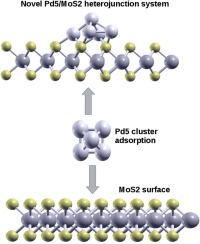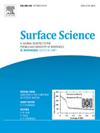一种新型 MoS2/Pd5 纳米簇异质结系统,具有更好的表面活性,可用于高效气体传感:DFT 研究
IF 2.1
4区 化学
Q3 CHEMISTRY, PHYSICAL
引用次数: 0
摘要
由于独特的 Pd 纳米簇/MoS2 异质结系统在材料科学、化学和物理学中的潜在应用,我们的工作反映了人们对这种系统的浓厚兴趣。我们重点研究了 Pd5/MoS2 纳米簇系统,这是一种用于气体传感应用的新型异质结材料。此外,我们还对 MoS2 表面掺杂钯的电子特性进行了比较研究。我们的 DFT 计算表明,Pd5/MoS2 异质结结构对 CO、NH3、NO 和 NO2 等气体分子具有更高的吸附亲和力,而完美的 MoS2 对气体的吸附能力较弱。Pd5/MoS2 异质结具有半导体特性,带隙减弱且更窄,因此具有更高的导电性,更适用于气体传感。我们分析了异质结表面吸附气体的吸附距离/能量、态密度、带结构和电子密度差等重要因素。根据电子密度差图,我们可以看到吸附分子上以及吸附原子间电荷的巨大增长。根据我们的研究结果,纳米材料的电导率发生了显著变化,这有助于加强 Pd5/MoS2 异质结纳米系统在传感和吸附气体分子方面的适用性。本文章由计算机程序翻译,如有差异,请以英文原文为准。

A novel MoS2/Pd5 nanocluster heterojunction system with improved surface reactivity for efficient gas sensing: A DFT study
Our work has reflected considerable interest in unique Pd nanocluster/MoS2 heterojunction systems due to their potential applications in materials science, chemistry and physics. We focused on exploiting Pd5/MoS2 nanocluster system, a novel heterojunction material for gas sensing applications. In addition, we exploited the electronic properties of Pd dopant on the MoS2 surface to make a comparative study. Our DFT calculations indicate that the Pd5/MoS2 heterojunction structure exhibits a higher affinity for adsorbing gas molecules such as CO, NH3, NO, and NO2, while the perfect MoS2 shows weak gas adsorption capacity. Pd5/MoS2 heterojunction exhibits semiconducting feature with a weakened and narrower band gap, making it more suitable for gas sensing due to its higher conductivity. We analyzed important factors like adsorption distance/energies, density of states, band structure and difference of electron density concerning adsorbed gases on the heterojunction surface. Based on the electron density difference maps, we can see the giant growth of charges over the adsorbed molecules, as well as between the adsorbing atoms. Based on our findings, the conductivity of the nanomaterial undergoes a remarkable change, which helps reinforce the applicability of the Pd5/MoS2 heterojunction nanosystem in sensing and adsorbing gas molecules.
求助全文
通过发布文献求助,成功后即可免费获取论文全文。
去求助
来源期刊

Surface Science
化学-物理:凝聚态物理
CiteScore
3.30
自引率
5.30%
发文量
137
审稿时长
25 days
期刊介绍:
Surface Science is devoted to elucidating the fundamental aspects of chemistry and physics occurring at a wide range of surfaces and interfaces and to disseminating this knowledge fast. The journal welcomes a broad spectrum of topics, including but not limited to:
• model systems (e.g. in Ultra High Vacuum) under well-controlled reactive conditions
• nanoscale science and engineering, including manipulation of matter at the atomic/molecular scale and assembly phenomena
• reactivity of surfaces as related to various applied areas including heterogeneous catalysis, chemistry at electrified interfaces, and semiconductors functionalization
• phenomena at interfaces relevant to energy storage and conversion, and fuels production and utilization
• surface reactivity for environmental protection and pollution remediation
• interactions at surfaces of soft matter, including polymers and biomaterials.
Both experimental and theoretical work, including modeling, is within the scope of the journal. Work published in Surface Science reaches a wide readership, from chemistry and physics to biology and materials science and engineering, providing an excellent forum for cross-fertilization of ideas and broad dissemination of scientific discoveries.
 求助内容:
求助内容: 应助结果提醒方式:
应助结果提醒方式:


